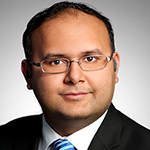
SPECIAL SPONSORED CONTENT

Amol Sodhi,
Vice President and Director at
TD Asset Management
The industry needs to rethink some of its assumptions about retirement planning,” asserts Amol Sodhi, Vice President and Director at TD Asset Management. Sodhi is a senior Portfolio Manager and co-manages TD Comfort Portfolios, TD Retirement Portfolios and TD Strategically Managed Portfolios. The traditional asset mix of a typical retirement portfolio is not sufficient to deal with the Canadian reality of decumulating assets during a long retirement, Sodhi contends.
These traditional portfolio mixes were designed by the industry to focus more on accumulating retirement assets and may not be appropriate for investors actually in retirement. Furthermore, Sodhi notes that current population, longevity and market trends of lower returns also require a reboot of how investors and investment professionals view retirement income. A new approach that focuses on diversifying by risk factors, rather than just asset classes, may be required. This new approach aims to not only deliver the best possible outcomes for retiree investors, but better utilizes the benefits of diversification to help improve the overall investment journey. However, this may require advisors and other industry professionals to take another look at how they approach their business and their clients’ portfolios.
“The customary conservative, balanced and aggressive portfolio continuum was really designed by the industry for the accumulating client,” says Sodhi. “For the past 10–30 years, the business has been focused on this segment because it was the biggest in the industry. But these portfolios were just not designed with the objective of providing stable and predictable retirement income over a long period of time.”
Why rethink retirement?
Sodhi groups the issues driving the retirement “rethink” into three broad categories: population demographics, life expectancy and the nature of fixed income markets themselves:
- Material shift in demographics: It’s hardly new information, but it bears repeating: the baby boom generation currently transitioning into retirement is leading to the biggest cohort of seniors and retirees in history. 1 In Canada, at least half a million people will retire each year for the next 15 years. 2 This creates a dominant market segment that the industry needs to better serve.
- Increased life expectancy: It’s well known that lifespans are increasing in the industrialized world, but the impact of this development on investment and saving merits further attention. Currently, there is a more than 40% chance someone turning 65 now will live past 90. 3 Stated in investment terms, this means that the time horizon for decumulation in retirement is almost equal
to the time horizon for accumulation. This makes effective investing while in retirement even more critical than before. - A new normal for fixed income markets: Despite the recent cycle of interest-rate increases from several central banks, interest rates were still historically low at the beginning of 2019. And recent economic uncertainty has central banks now holding off on further interest-rate normalization, meaning the current low-rate and low-yield environment will likely continue for longer than anticipated. Returns from investments based on interest rates may not be adequate for the current and upcoming generation of retirees.
Diversifying by risk exposure, not asset allocation
If the interest-rate-heavy traditional retirement portfolio is no longer suitable for this generation of long-lived retirees, what options do advisors and investment managers have? Increasing equity exposure could be one solution, as long-term equity prices are generally driven by fundamentals. However, increasing equity exposure alone can increase a portfolio’s volatility profile, potentially beyond an investor’s comfort level and introduces new investment risks such as sequence of returns risk.
Sodhi believes advisors and other investment professionals need to change the types of conversations they are having with clients, and also change their own approaches to portfolio construction. The key remains portfolio diversification, but a diversification strategy that is based on risk-factor exposures, rather than just asset classes.
“A 100% equity portfolio is not necessarily the highest risk”
Risk factors are often viewed as distinct exposures or investment attributes credited with driving investment returns under certain conditions. Some concrete examples of where risk-factor analysis offers additional insights include the following scenarios:
- The risk of “safe” investments: An investment that offers low returns but preservation of capital may still be attractive to many investors. That is, until they are introduced to the concept of inflation risk, and the loss of actual purchasing power their safe assets may have in the future.
- Commonalities across asset classes: Certain types of stocks and fixed income instruments may be driven by the same risk factors. For example, the yields and capital returns on investment-grade corporate bonds are still driven in part by corporate earnings, and in some cases by the returns of the stocks of the same company. Exposure to this risk means that investors may not be getting the level of diversification they were seeking through these two asset classes alone.
- Volatility within asset classes: A simple breakdown of a portfolio by broad asset classes does not take into consideration the risk profile of holdings within those asset classes. For example, a portfolio with a 20% equity holding in an S&P 500 Index fund will likely have less expected volatility than another portfolio with a 20% equity holding in a NASDAQ index fund.
An investor’s goals are the true benchmark
Risk-factor analysis reframes the asset allocation question, which allows advisors and investors to work together to formulate portfolios that better serve clients’ goals and desired outcomes. These portfolios can also include solutions that are optimized by risk factor, leveraging the expertise of investment managers with strong risk analysis capabilities to help ensure investors have an asset mix that can take them down a much longer road in retirement.
“A 100% fixed income portfolio is not necessarily low risk, and a 100% equity portfolio is not necessarily the highest risk,” Sodhi says. “Advisors need to be even more focused than ever on investor goals and desired outcomes, and on understanding their client’s investment risk budget: what their allowable risk is, versus what their cash flow needs are. That means looking at a client’s goals as the true benchmark, rather than any industry standard. When it comes to retirement investing, I believe that’s the solution. And I believe as a market leader in retirement solutions, TD Asset Management can play a critical role in this repositioning of client portfolios to reflect the new economic reality that Canadians face.”
To learn more about the future of retirement income and risk-factor optimization, watch recording for TD Asset Management’s webinar and get CE credits (The Institute and IIROC credits pending) or contact TD Asset Management today.
1 Statistics Canada, “Age and sex, and type of dwelling data: Key results from the 2016 Census,” May 3, 2017;
Statistics Canada, “A portrait of the population aged 85 and older in 2016 in Canada,” May 3, 2017.
2 “The Retirement Income Conundrum: How status quo may not be enough for the next generation of retirees,” TD Asset Management, February 2018;
Statistics Canada, CANSIM Table 109-5202, February 2018.
3 TD Asset Management calculations; Statistics Canada, CANSIM Table 109-5202, February 2018.
The information contained herein has been provided by TD Asset Management Inc. and is for information purposes only. The information has been drawn from sources believed to be reliable. The information does not provide financial, legal, tax or investment advice. Particular investment, tax, or trading strategies should be evaluated relative to each individual’s objectives and risk tolerance. Certain statements in this document may contain forward- looking statements (“FLS”) that are predictive in nature and may include words such as “expects”, “anticipates”, “intends”, “believes”, “estimates” and similar forward-looking expressions or negative versions thereof. FLS are based on current expectations and projections about future general economic, political and relevant market factors, such as interest and foreign exchange rates, equity and capital markets, the general business environment, assuming no changes to tax or other laws or government regulation or catastrophic events. Expectations and projections about future events are inherently subject to risks and uncertainties, which may be unforeseeable. Such expectations and projections may be incorrect in the future. FLS are not guarantees of future performance. Actual events could differ materially from those expressed or implied in any FLS. A number of important factors including those factors set out above can contribute to these digressions. You should avoid placing any reliance on FLS. TD Mutual Funds, TD Managed Assets Program Portfolios and TD ETFs are managed by TD Asset Management Inc., a wholly-owned subsidiary of The Toronto-Dominion Bank and are available through authorized dealers. TD Asset Management Inc. is a wholly-owned subsidiary of The Toronto-Dominion Bank.® The TD logo and other trade-marks are the property of The Toronto-Dominion Bank.
